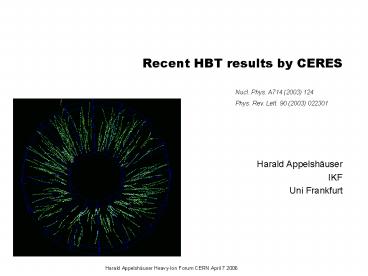Recent HBT results by CERES - PowerPoint PPT Presentation
1 / 26
Title:
Recent HBT results by CERES
Description:
Harald Appelsh user Heavy-Ion Forum CERN April 7 2006. Recent HBT results by CERES. Harald Appelsh user. IKF. Uni Frankfurt. Nucl. Phys. A714 (2003) 124. Phys. Rev. ... – PowerPoint PPT presentation
Number of Views:52
Avg rating:3.0/5.0
Title: Recent HBT results by CERES
1
Recent HBT results by CERES
Nucl. Phys. A714 (2003) 124
Phys. Rev. Lett. 90 (2003) 022301
- Harald Appelshäuser
- IKF
- Uni Frankfurt
2
Why HBT?
- the most expensive way to measure the number 6
- space-time evolution vector mesons
- s-production
- generation of flow
3
Hydro models
M. Lisa, S. Pratt, R. Soltz, U. Wiedemann,
nucl-ex/0505014
4
Why HBT?
- the most expensive way to measure the number 6
- space-time evolution vector mesons
- s-production
- generation of flow
- the long-lived source
5
HBT Interferometry
p1
r1
Bose-Einstein statistics of identical bosons
leads to short-range correlations in momentum
space
r2
p2
First application with photons size of stars (R.
Hanbury-Brown, R.Q. Twiss, 1956)
?p
In heavy-ion reactions pions, kaons,
6
HBT in expanding systems
- space-momentum correlations
- pions with similar momenta (small q) are
- preferentially emitted from close-by regions
- length of homogeneity
? thermal vs. geometrical length scale
- HBT radii depend on mt
- differential HBT-analysis as function of mt
- contains information about source
- expansion
7
CERES Experiment
TPC
0 lt f lt 2p 2.1 lt h lt 2.6
Pb-Au 158 AGeV/c
TPC age 1999 40 AGeV/c 8M Pb-Au events 2000
80 AGeV/c 1 M Pb-Au events 2000 158 AGeV/c
35M Pb-Au events
8
Bertsch-Pratt Parametrization
in LCMS
Rlong longitudinal expansion and lifetime
tf Rside transverse size, radial
expansion Rout as Rside but also duration
of emission Dt
9
Analysis of correlation function
Coulomb repulsion
CERES 158A GeV/c Pb-Au Nucl. Phys. A714 (2003)
124
q lt 0.03 GeV/c
? Rlong, Rside, Rout
10
Sensitivity to Coulomb treatment
Coulomb repulsion
CERES 158A GeV/c Pb-Au Nucl. Phys. A714 (2003)
124
Boxes no Coulomb Triangles full
Coulomb Open circles w(kt) 1 Full circles
final result
? Strong sensitivity of Rout to the treatment of
Coulomb repulsion
11
Momentum resolution
12
Momentum resolution
Rlong Rside Rout
H. Tilsner PhD Thesis Heidelberg
13
Rlong longitudinal expansion and lifetime
? Hubble-Expansion
for Tf 160 120 MeV
14
Rside transverse expansion and geometry
CERES Pb-Au Nucl. Phys. A714 (2003) 124
gt15
10-15
5-10
0-5
hf2 strength of transverse
expansion (U. Heinz, B. Tomasik, U. Wiedemann)
lt vt gt 0.5-0.6c
for Tf 160 120 MeV
1/vmt (1/vGeV)
15
Rout emission duration
CERES Pb-Au Nucl. Phys. A714 (2003) 124
gt15
10-15
5-10
0-5
Generally
At 158 AGeV Short but finite emission duration
from
kt (GeV/c)
16
HBT radii AGS SPS RHIC
CERES Nucl. Phys. A714 (2003) 124
Rlong increase SPS ? RHIC?
but by and large a weak Ebeam dependence
? is there a universal freeze-out criterion?
17
Freeze-out condition
This compilation D. Brinkmann M.Gazdzicki QM1995
18
Freeze-out volume
freeze-out volume Vf
Centrality dependence
CERES Phys. Rev. Lett. 90 (2003) 022301
since
? ????
only at given beam energy!!
19
Freeze-out volume vs. beam energy
freeze-out volume Vf
- surprise non-monotonic behaviour
- minimum between AGS and SPS
20
Particle multiplicity vs. beam energy
CERES Phys. Rev. Lett. 90 (2003) 022301
- particle number increases monotonically
- ? freeze-out at constant density excluded
- chemical composition changes
- cross sections are very different
- ? try mean free path
vs(GeV)
21
Mean free path
CERES Phys. Rev. Lett. 90 (2003) 022301
in a composed medium
vs(GeV)
- also Ns shows non-monotonic behaviour
- dominated by baryons at low energy and mesons at
high energy
22
Universal pion freeze-out
CERES Phys. Rev. Lett. 90 (2003) 022301
- ? Ns follows Vf
- data are consistent with constant
- mean free path at freeze-out
independent of beam energy and centrality
vs(GeV)
23
Universal freeze-out II
- universal pion freeze-out
- independent of beam energy and
- system size
- in A-A lf ltlt R
- why no dependence on beam energy and system
size? - why so small?
lf (fm)
sqrt(sNN) (GeV)
..implies f.o. at constant density
(R(dNch/dh)1/3) if particle ratios are constant!
24
Rlong rapidity dependence
Stefan Kniege (NA49) Kromeriz 2005 nucl-ex/0601
024
NA49 20 AGeV 30 AGeV 40 AGeV 80 AGeV 158
AGeV kt 50 MeV/c
NA49 20 AGeV 30 AGeV 40 AGeV 80 AGeV 158
AGeV kt 50 MeV/c
Rlong (fm)
Rlong (fm)
ypp - ymid
ypp - ybeam
25
Rlong rapidity dependence
Rlong (fm)
- delayed freeze-out in the
- fragmentation region due to baryons?
- relativistic effect?
ypp - ybeam
26
?
?
Rlong (fm)
(dNch/dh)1/3
RHIC
LHC
SPS
AGS
ypp - ybeam































